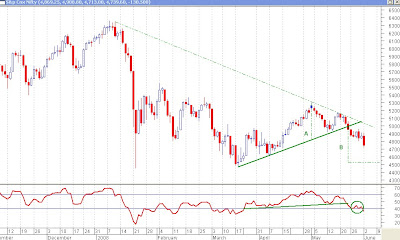It was a bad day for the markets today. The Nifty opened flat today and tried on three occasions to go above 4900 but could not sustain itself at those high levels. And by 11:40, it was clear that the Nifty would come down. But what ensued was not what had been anticipated by day traders. The Nifty dropped almost 180 points from the highs of the day. By the end of it all, everything was looking red, the screen was red, the charts showed all red and there was ‘blood on the street’, again red.
However, it wasn’t such a bad day for technical analysts. The swing traders had already anticipated a fall when the Nifty went below 4990. All stop losses for long positions were hit and they were, and still are, merrily sitting on cash, anticipating further downfall. While they do have a target in mind (in my case, it is between 4500 and 4550, and some are even anticipating 3800), they will buy only when the Nifty gives a signal to buy. It may mean missing out on a small portion of the decline/rally but it captures most of the move. There are different theories in technical analysis – one which tells analysts to execute their trades when the target is achieved and another which tells us to buy or sell only when a buy/sell signal is received. I like to follow both theories. For example, in this case, I would look to invest 50% of my money when the target is achieved i.e. when the Nifty goes below 4550 and I would invest the remaining 50% when a buy signal is received, even if it comes at 4800. Both methods have their own pros and cons and I will, probably, talk about them in one of my weekend posts which come under the ‘Lessons on Investing’ category. You can click on “Lessons on Investing” anytime in the label cloud on the right to read such posts.
However, it wasn’t such a bad day for technical analysts. The swing traders had already anticipated a fall when the Nifty went below 4990. All stop losses for long positions were hit and they were, and still are, merrily sitting on cash, anticipating further downfall. While they do have a target in mind (in my case, it is between 4500 and 4550, and some are even anticipating 3800), they will buy only when the Nifty gives a signal to buy. It may mean missing out on a small portion of the decline/rally but it captures most of the move. There are different theories in technical analysis – one which tells analysts to execute their trades when the target is achieved and another which tells us to buy or sell only when a buy/sell signal is received. I like to follow both theories. For example, in this case, I would look to invest 50% of my money when the target is achieved i.e. when the Nifty goes below 4550 and I would invest the remaining 50% when a buy signal is received, even if it comes at 4800. Both methods have their own pros and cons and I will, probably, talk about them in one of my weekend posts which come under the ‘Lessons on Investing’ category. You can click on “Lessons on Investing” anytime in the label cloud on the right to read such posts.
 We have the daily chart of the Nifty with us today. I’ve not included many things on the charts today, so as to keep it very simple for the readers. I am now going to explain what I have included, what my reading is about the chart and why I feel so. I always like to give reasons for my analysis and it is there for everybody to see. As you can see from the chart, there are two trendlines – a downward sloping dashed trendline and an upward sloping solid trendline. The solid trendline shows where the Nifty broke through the support line and showed that a downtrend could start. And the dashed trendline shows the level above which the Nifty should come back in an uptrend. As one can see, and as has been mentioned, a downtrend was signaled when the Nifty came below 4990 and an uptrend would be signaled when the Nifty crosses the dashed trendline which today stands at 5020. Since this line is sloping downwards, this level would keep changing everyday.
We have the daily chart of the Nifty with us today. I’ve not included many things on the charts today, so as to keep it very simple for the readers. I am now going to explain what I have included, what my reading is about the chart and why I feel so. I always like to give reasons for my analysis and it is there for everybody to see. As you can see from the chart, there are two trendlines – a downward sloping dashed trendline and an upward sloping solid trendline. The solid trendline shows where the Nifty broke through the support line and showed that a downtrend could start. And the dashed trendline shows the level above which the Nifty should come back in an uptrend. As one can see, and as has been mentioned, a downtrend was signaled when the Nifty came below 4990 and an uptrend would be signaled when the Nifty crosses the dashed trendline which today stands at 5020. Since this line is sloping downwards, this level would keep changing everyday.The next thing that can be seen from the chart are the two vertical dashed lines marked ‘A’ and ‘B’. Line A measures the distance from the top of the recent uptrend to the trendline on that day. This line A has then been superimposed at the point where the Nifty broke through the trendline and this superimposed line is marked as B. The logic is that the downtrend should be as brief (or as severe) as the uptrend was, though, in some cases there is a possibility of it getting extended too. This superimposed line, thus, gives us a target of 4530 on the Nifty. Since this target is usually not exact, I’m taking it as between 4500 and 4550. You will notice that the same principle is used when calculating the targets for head and shoulders patterns, double/triple tops/bottoms. If you look at the pattern formed from where the solid line starts to where it ends, it does look like a head and shoulders pattern, though, with a very slanted neckline. You will also notice that the Relative Strength Index (RSI) has made a much easier to imagine bearish head and shoulders pattern. Also, one should notice the RSI within the small circle. Since the last week, the RSI was repeatedly finding support at 40, which in itself is not a bullish sign, but is definitely a positive sign which suggests that the market was showing some strength because of which the RSI was finding difficulty going below 40. This strength has been negated today with the RSI advancing to levels lower than 40.
Again, we are not looking at charts of any stocks these days because it is not the time to buy as we are still in an intermediate term downtrend. When the market again shows signs of improvement and there are some buying opportunities available, some of them worth a mention would find their way through on this page.
Happy Investing!!!






No comments:
Post a Comment